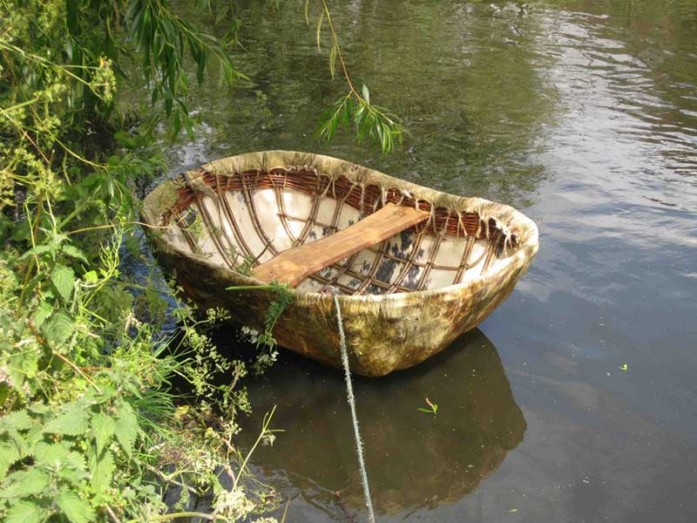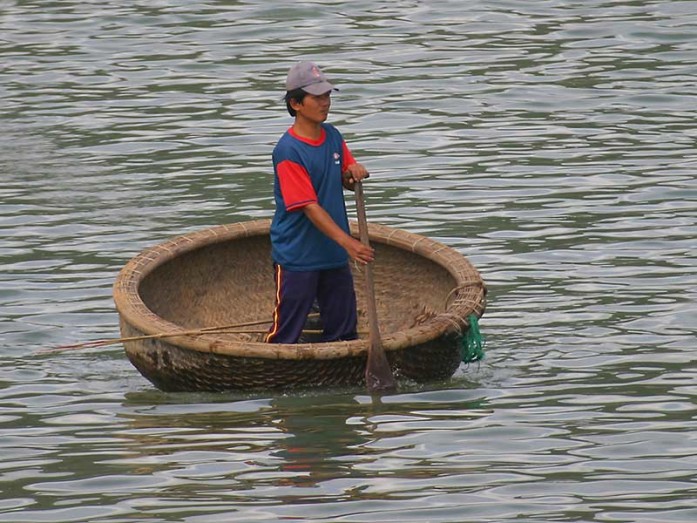The coracle is a small, round boat made of wickerwork or laths covered with a waterproofed layer of animal skin or fabric used in Wales, Ireland, and parts of western England. I found this beautiful fragment somewhere: “In times gone by, people living on the many small islands of Scotland would carry food and comfort to their neighbors using a small boat, called a coracle. A coracle is a carrier of nurturing friendship”. Very beautiful, but everything else I found about this boat, is based on the Wikipedia article and definitions.
I have to use the same article, so please excuse me if I’m going to repeat already published things, but the reasons are purely academic. This is a specialized site, and Encyclopedia is a specialized category already based especially on Wikipedia, and only after, on other sources. Of course that if I know more than the Wikipedia article’s author about a thing or another, I shall specify it here regardless of you believing me or not.

A coracle in Scotland
[source]
Oval in shape and very similar to half a walnut shell, the structure is made of a framework of split and interwoven willow rods, tied with willow bark. The outer layer was originally an animal skin such as horse or bullock hide (corium), with a thin layer of tar to make it fully waterproof – today replaced by tarred calico or canvas, or simply fiberglass. The Vietnamese/Asian version of the coracle is made somewhat differently: using interwoven bamboo and waterproofed by using resin and coconut oil. The structure has a keel-less, flat bottom to evenly spread the weight of the boat and its load across the structure and to reduce the required depth of water – often to only a few inches, making it ideal for use on rivers.

A coracle in Vietnam
[source]
Each coracle is unique in design, as it is tailored to the river conditions where it was built and intended to be used. In general there is one design per river, but this is not always the case. The Teifi coracle, for instance, is flat-bottomed, as it is designed to negotiate shallow rapids, common on the river in the summer, while the Carmarthen coracle is rounder and deeper, because it is used in tidal waters on the Tywi, where there are no rapids. Teifi coracles are made from locally harvested wood – willow for the laths (body of the boat), hazel for the weave (Y bleth in Welsh – the bit round the top) – while Tywi coracles have been made from sawn ash for a long time. The working boats tend to be made from fiberglass these days. Teifi coracles use no nails, relying on the interweaving of the laths for structural coherence, whilst the Carmarthen ones use copper nails and no interweaving.
They are an effective fishing vessel because, when powered by a skilled person, they hardly disturb the water or the fish, and they can be easily maneuvered with one arm, while the other arm tends to the net; two coracles to a net. The coracle is propelled by means of a broad-bladed paddle, which traditionally varies in design between different rivers. It is used in a sculling action, the blade describing a figure-of-eight pattern in the water. The paddle is used towards the front of the coracle, pulling the boat forward, with the paddler facing in the direction of travel.
Another important aspect to the Welsh Coracle is that it can be carried on his back by one person.
The load of a man is his coracle – Welsh saying
If you like what you read, please subscribe to this blog by completing the form. If you want to help more, start by following us on Twitter, and like our page on Facebook. You don’t know what good things may happen. To lighten your day, check our pins on Pinterest, we can be friends there too. Oh, and if you need a really good looking blog attached to your site, or just for fun, to express your feelings more competitively, read this Own Your Website offer! Thank you very much.
